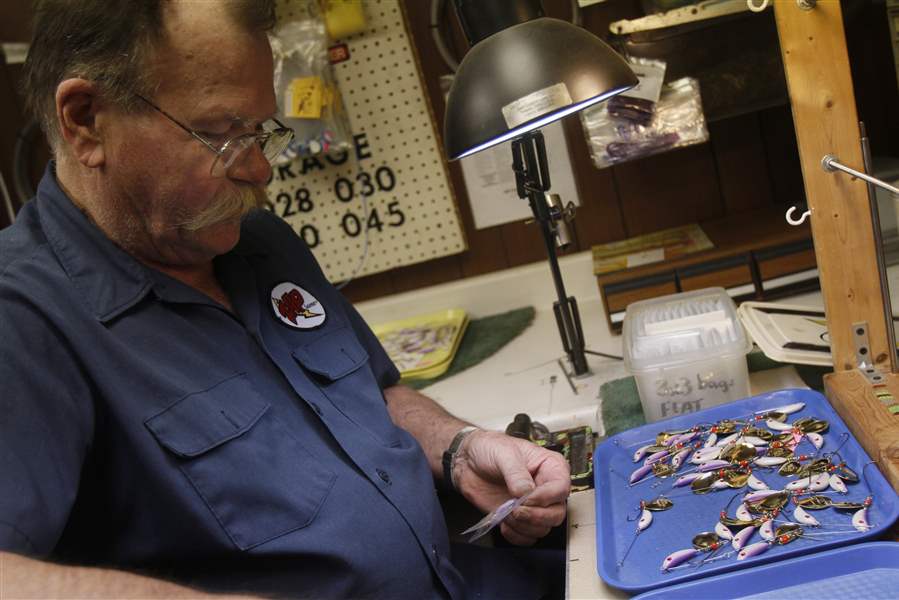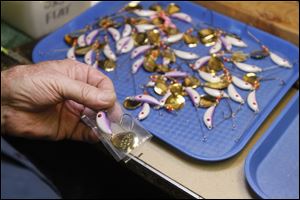
Toledoan lures anglers
Bryant's tackle putting fish in creels for decades
5/28/2012
Dennis Bryant fashions his custon lures in Toledo with input from anglers and charter boat captains.
The Blade/Zack Conkle
Buy This Image

Dennis Bryant fashions his custon lures in Toledo with input from anglers and charter boat captains.
The sophisticated electronics involved in fishing today amaze an avowed old-timer like Dennis Bryant.
He was there when tournament bass fishing had its real genesis, way back in the 1960s. At that time, the limited assortment in your tackle box consisted primarily of a creek chub, a hula popper, and a plastic worm. If you could splurge on exotic gear, your fish-finder was a primitive flasher that told you where the bottom was, and very little else.
Now, the high-tech equipment involved in fishing takes us directly into the world underwater. Anglers can get minutely-detailed images in 3-D, color, and even side views of the fish and structure below. GPS can bring you back to a productive spot with exact precision, days, weeks, or months later.
"But one thing has never changed -- you still have to catch the fish," said Bryant, a native Toledoan. "You can have all of the most expensive gadgets in the world to help you find the fish, but the catching part -- that's still on you. And to do that, you have to have the right lure."

Zap Custom Lure Co. prides itself as the only lure maker to use only American-made components on Lake Erie.
This is the point where the affable and mustachioed 68-year-old Bryant gets that twinkle in his eye. He believes that dedicating a generous portion of the last half century to cracking the code that dictates the mind, mood, and mentality of bass and other game fish makes the enticement part of fishing his strength.
In 1965, Bryant was tournament fishing on the weekends, chasing bass all over the region, but was frustrated by the lack of consistent production from the lures of the era. An avowed tinkerer, he went to work in the basement of his home in Toledo's south end, intent on crafting an angler's version of a better mouse trap.
When his homemade lures started producing tournament wins, his competitors became his customers. By 1971, Bryant's Zap Custom Lure Co. was a legitimate business. He originally offered one product -- a spinner bait -- in six different colors and two weights.
The venture outgrew his basement, ate up four to six hours each evening after he completed the work day as a lineman for Toledo Edison, and over time expanded exponentially.
From his current storefront/factory operation on Upton Avenue, where he manufactures lures that target bass, walleye, crappie, perch, and other popular game fish, Bryant offers his customers about two million options with the seemingly infinite size, shape, weight, color, and configuration variables. He went from making 100 lures on a good day, to now crafting 2,500 a day.
"It is no exaggeration to say the possibilities are limitless. When you start making fishing lures, there's really no end to what you can do," Bryant said.
After fishing bass tournaments for more than two decades, Bryant spent a couple of years competing on the walleye circuit before making the lure operation his full-time fishing partner. He retired from Edison in 1993, and in 2000 bought out the famed Original Parrish Lure Company.
His experience as a competitive fisherman gave him both credibility, and the contacts to keep up with the latest trends in the lure-making industry. Many of his best-selling products are the result of suggestions by veteran bass pros or Lake Erie charter captains, and the never-ending process of tweaking these lures to match those masters of finicky -- the fish.
"I used to use whatever was on the market, but when I started to use his lures, I definitely got more production at different times of the year," said Capt. Dale Swartz of Storm Front Walleye Charters. "He tests these lures, then he makes changes so they work even better. Dennis was a serious fisherman before he was a lure maker, so he knows what this is all about."
Bryant uses only American made materials -- hooks from Missouri, wire from Minnesota, paints from Wisconsin, skirts from California -- and has custom made many of the molds in his shop. Even with numerous innovations and advances in production, it is still a very labor intensive operation. Some of the Lake Erie weight-forward walleye lures he makes require 20 steps to complete.
"Back when I first started, it would have been impossible to imagine that it could grow into all of this," Bryant said. "I guess when fishermen or charter captains come to me and ask 'can you make this' I've never been very good at saying 'no'. There's not too many things I can't make, when it comes to fishing lures."
Swartz, one of numerous area charter operators who use Zap Custom Lures on their Lake Erie outings, said his choice of fishing tackle is strictly a business decision.
"My job is to take people out and catch fish, so I have to have the best stuff on the market," Swartz said. "If my customers are not catching fish, they won't come back, but his lures catch fish. You don't stay alive in this business unless you are making lures that work, so I won't use anybody else's lures."
More than 40 years ago, Bryant was one of the first members of a fledgling group called the Bass Anglers Sportsman Society -- B.A.S.S. -- which has grown into a mega venture with several nationwide tours, and first-place prize money of a half-million dollars in its "Super Bowl" event.
He has seen the fishing industry explode, locally and nationally, and as he moved from that basement work bench to the complex operation he shepherds today. Recently, as he filled an order for several hundred custom lures placed by the operator of a remote fishing camp in Canada, Bryant jokingly touched on his only regret after nearly 50 years of making lures.
"I'm very happy with what I do, since I'm talking to fishermen all the time and I'm surrounded by fishing equipment every day of my life," Bryant said. "The only real problem is that I still love to fish, and when you work for yourself, getting the boss to give you a day off to go fishing is really tough."
Contact Blade outdoors editor Matt Markey at: mmarkey@theblade.com or 419-724-6068.